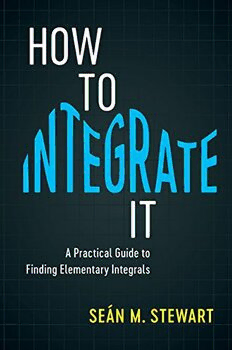Table Of ContentHowtoIntegrateIt
APracticalGuidetoFindingElementaryIntegrals
Whiledifferentiatingelementaryfunctionsismerelyaskill,findingtheirintegralsis
anart.Thispracticalintroductiontotheartofintegrationgivesreadersthetoolsand
confidencetotacklecommonanduncommonintegrals.
AfterareviewofthebasicpropertiesoftheRiemannintegral,eachchapteris
devotedtoaparticulartechniqueofelementaryintegration.Thoroughexplanations
andplentifulworkedexamplespreparethereaderfortheextensiveexercisesattheend
ofeachchapter.Theseexercisesincreaseindifficultyfromwarm-upproblems,
throughdrillexamples,tochallengingextensionsthatillustratesuchadvancedtopics
astheirrationalityof(cid:2) ande,thesolutionoftheBaselproblem,Leibniz’sseries,and
Wallis’sproduct.
Theauthor’saccessibleandengagingmannerwillappealtoawideaudience,
includingstudents,teachers,andself-learners.Itcanserveasacompleteintroduction
tofindingelementaryintegrals,orasasupplementarytextforanybeginningcoursein
calculus.
How to Integrate It
A Practical Guide to Finding Elementary Integrals
SEÁN M. STEWART
OmegadotTuition,Sydney
UniversityPrintingHouse,CambridgeCB28BS,UnitedKingdom
OneLibertyPlaza,20thFloor,NewYork,NY10006,USA
477WilliamstownRoad,PortMelbourne,VIC3207,Australia
314–321,3rdFloor,Plot3,SplendorForum,JasolaDistrictCentre,
NewDelhi-110025,India
79AnsonRoad,#06-04/06,Singapore079906
CambridgeUniversityPressispartoftheUniversityofCambridge.
ItfurtherstheUniversity’smissionbydisseminatingknowledgeinthepursuitof
education,learning,andresearchatthehighestinternationallevelsofexcellence.
www.cambridge.org
Informationonthistitle:www.cambridge.org/9781108418812
DOI:10.1017/9781108291507
©SeánM.Stewart2018
Thispublicationisincopyright.Subjecttostatutoryexception
andtotheprovisionsofrelevantcollectivelicensingagreements,
noreproductionofanypartmaytakeplacewithoutthewritten
permissionofCambridgeUniversityPress.
Firstpublished2018
PrintedintheUnitedKingdombyClays,StIvesplc
AcataloguerecordforthispublicationisavailablefromtheBritishLibrary
ISBN978-1-108-41881-2Hardback
ISBN978-1-108-40819-6Paperback
CambridgeUniversityPresshasnoresponsibilityforthepersistenceoraccuracy
ofURLsforexternalorthird-partyinternetwebsitesreferredtointhispublication,
anddoesnotguaranteethatanycontentonsuchwebsitesis,orwillremain,
accurateorappropriate.
Contents
Preface pagevii
1 TheRiemannIntegral 1
2 BasicPropertiesoftheDefiniteIntegral:PartI 20
3 SomeBasicStandardForms 25
4 BasicPropertiesoftheDefiniteIntegral:PartII 36
5 StandardForms 53
6 IntegrationbySubstitution 64
7 IntegrationbyParts 79
8 TrigonometricIntegrals 105
9 HyperbolicIntegrals 119
10 TrigonometricandHyperbolicSubstitutions 134
11 IntegratingRationalFunctionsbyPartialFraction
Decomposition 144
12 SixUsefulIntegrals 157
13 InverseHyperbolicFunctionsandIntegralsLeadingto
Them 169
14 TangentHalf-AngleSubstitution 178
15 FurtherTrigonometricIntegrals 188
16 FurtherPropertiesforDefiniteIntegrals 209
v
vi Contents
17 IntegratingInverseFunctions 233
18 ReductionFormulae 242
19 SomeOtherSpecialTechniquesandSubstitutions 264
20 ImproperIntegrals 274
21 TwoImportantImproperIntegrals 298
AppendixA:PartialFractions 313
AppendixB:AnswerstoSelectedExercises 333
Index 365
Preface
Calculus occupies an important place in modern mathematics. At its heart it
is the study of continuous change. It forms the foundation of mathematical
analysis while the immense wealth of its ideas and usefulness of the tools to
haveemergedfromitsdevelopmentmakeitcapableofhandlingawidevariety
ofproblemsbothwithinandoutsideofmathematics.Indeed,thesheernumber
of applications that the calculus finds means it continues to remain a central
component for any serious study of mathematics for future mathematicians,
scientists,andengineersalike.
Thematerialpresentedinthisvolumedealswithoneofthemajorbranches
ofcalculusknownastheintegralcalculus–theotherbeingthedifferential,with
thetwobeingintimatelybound.Theintegralcalculusdealswiththenotionof
anintegral,itsproperties,andmethodofcalculation.Ourwordfor‘integrate’is
derivedfromtheLatinintegratusmeaning‘tomakewhole’.Ascalculusdeals
withcontinuouschange,integration,then,isageneralmethodforfindingthe
wholechangewhenyouknowalltheintermediate(infinitesimal)changes.
AprecursortotheconceptofanintegraldatesbacktotheancientGreeks,to
EudoxusinthefourthcenturybceandArchimedesinthethirdcenturybce,and
theirworkrelatedtothemethodofexhaustion.Themethodofexhaustionwas
usedtocalculateareasofplanefiguresandvolumesofsolidsbasedonapprox-
imatingtheobjectunderconsiderationbyexhaustivelypartitioningitintoever
smallerpiecesusingthesimplestpossibleplanarfiguresorbodies,suchasrect-
anglesorcylinders.Summingitsconstituentpartstogetherthengavethearea
or volume of the whole. Integration thus renders something whole by bring-
ing together all its parts. Its modern development came much later. Starting
inthelateseventeenthcenturywiththeseminalworkofNewtonandLeibniz,
it was carried forward in the eighteenth century by Euler and the Bernoulli
brothers, Jacob and Johann, and in the nineteenth century most notably by
CauchybeforethefirstrigoroustreatmentoftheintegralwasgivenbyRiemann
vii
viii Preface
duringthemiddlepartofthatcentury.Sincethistimemanyothernotionsfor
the integral have emerged. In this text we focus exclusively on the first and
perhapssimplestofthesenotionstoemerge,thatoftheRiemannintegral.
Unlikedifferentiation,whichoncelearntismerelyaskillwhereasetofrules
areapplied,asthereisnosystematicprocedureforfindinganintegral,evenfor
functionsthatbehave‘nicely’,manylookuponintegrationasan‘art’.Finding
anintegraltendstobeacomplicatedaffairinvolvingasearchforpatternsand
ishardtodo.Theunavailabilityofamechanicalapproachtointegrationmeans
many different techniques for finding integrals of well-behaved functions in
termsoffamiliarfunctionshavebeendeveloped.Thismakesintegrationhard
andisexactlyhowitisperceivedbymostbeginningstudents.Whenencoun-
tering integration for the first time one is often bewildered by the number of
differentmethodsthatneedtobeknownbeforetheproblemofintegrationcan
besuccessfullytackled.
Thisbookisanattemptattakingsomeofthemysteryoutoftheartofinte-
gration.Thetextprovidesaself-containedpresentationofthepropertiesofthe
definite integral together with many of the familiar, and some not so famil-
iar,techniquesthatareavailableforfindingelementaryintegrals.Prerequisites
neededfortheproperstudyofthematerialpresentedinthetextareminimal.
The reader is expected to be familiar with the differential calculus including
theconceptofalimit,continuity,anddifferentiability,togetherwithaworking
knowledgeoftherulesofdifferentiation.
Thebooktakesthereaderthroughthevariouselementarymethodsthatcan
beusedtofind(Riemann)integralstogetherwithintroducinganddeveloping
thevariouspropertiesassociatedwiththedefiniteintegral.Thefocusisprimar-
ilyonideasandtechniquesusedforintegratingfunctionsandontheproperties
associatedwiththedefiniteintegralratherthanonapplications.Bydoingsothe
aimistodevelopinthestudenttheskillsandconfidenceneededtoapproach
thegeneralproblemofhowtofindanintegralintermsoffamiliarfunctions.
Oncethesehavebeendevelopedandthoroughlymastered,thestudentshould
beinafarbetterpositiontomoveontothemultitudeofapplicationstheinte-
gralfindsforitself.Ofcoursethisisnottosayapplicationsfortheintegralare
notto be found inthe text. They are. Whilethe text makes no attempt touse
integration to calculate areas or volumes in any schematic way, applications
developed through the process of integration that lead to important results in
otherareasofmathematicsaregiven.Asexamples,theproofoftheirrationality
ofthenumbers(cid:2) andeispresented,asarethesolutionstotheBaselproblem,
Leibniz’sseries,andWallis’sproduct.
Mostchaptersofthebookarequiteshortandsuccinct.Eachchapterisself-
contained and is structured such that after the necessary theory is introduced
Preface ix
and developed, a range of examples of increasing level of difficulty are pre-
sentedshowinghowthetechniqueisusedandworksinpractice.Alongtheway,
variousstrategiesandsoundadvicearegiven.Attheconclusionofeachchapter,
anextensivesetofexercisesappear.Thetextcanserveasacompleteintroduc-
tionandguidetofindingelementaryintegrals.Alternatively,itcanserveasa
resourceorsupplementaltextforanybeginningcourseincalculusbyallowing
studentstofocusonparticularproblemareastheymightbehavingbyworking
throughoneormorerelevantchaptersatatime.
Incontemplatingthematerialpresenteditcannotbeoverstatedhowimpor-
tantitisforonetoattempttheexerciseslocatedattheendofeachchapter.For
thosehopingtobecomefluentintheartofintegration,thisproficiencyisbest
gainedthroughperseveranceandhardwork,andinthepracticeofansweringas
manydifferentandvariedquestionsaspossible.Indeed,alargeportionofthe
textisdevotedtosuchexercisesandproblems;theyareaveryimportantcom-
ponentofthebook.Tohelpaidstudentsintheirendeavoursanattempthasbeen
made to divide the exercises that appear at the end of the chapters into three
types: (i) warm-ups, (ii) practice questions, and (iii) extension questions and
challengeproblems.Thewarm-upsarerelativelysimplequestionsdesignedto
gentlyeasethestudentintothematerialjustconsidered.Thepracticequestions
consolidate knowledge of the material just presented, allowing the student to
gainfamiliarityandconfidenceintheworkingsofthetechniqueunderconsid-
eration.Finally,theextensionquestionsandchallengeproblemscontainamix
ofquestionsthatareeithersimplychallenginginnatureorthatextend,inoften
quite unexpected ways, the material just considered. It is hoped many of the
questionsfoundinthislastgroupwillnotonlychallengethereaderbutpique
theirinterestasmoreadvancedresultsaregraduallyrevealed.Ofcourse,judg-
ingtheperceived levelofdifficultyisoftenintheeye ofthebeholder soone
mayexpectsomeoverlapbetweenthevariouscategories.Forproblemsconsid-
eredmoredifficult,hintsareprovidedalongthewayintheformofinterrelated
partsthatitishopedwillhelpguidethestudenttowardsthefinalsolution.In
all,wellover1,000problemsrelatingtofindingorevaluatingintegralsorprob-
lemsassociatedwithpropertiesforthedefiniteintegralcanbefounddispersed
throughouttheend-of-chapterexercisesets.
Chapter1introducesformallywhatwemeanbyanintegralintheRiemann
sense. The approach taken is one via Darboux sums. The fundamental theo-
remofcalculus,whichwedivideintwoparts,isalsogiven.Propertiesforthe
definite integral are given in three chapters (Chapters 2, 4, and 16). Sixteen
chapters(Chapters3and5–19)arethendevotedtoeitheraparticularmethod
thatcanbeusedtofindagivenintegraloraparticularclassofintegrals.Here
methods including standard forms, integration by substitution, integration by

